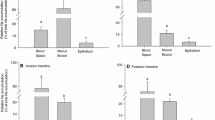Summary
-
1.
Goldfish were acclimated to temperatures of 10°C and 30°C for at least 4 weeks.
-
2.
Fish acclimated to 10°C have longer intestines with larger mucosal folds than fish acclimated to 30°C.
-
3.
When fish acclimated to 10°C are compared with 30°C fish, the electrical resistance of intestinal mucosa, expressed in Ωcm2 of serosal area, from 10°C-acclimated fish is higher. However when related to mucosal area, the resistance in 30°C-acclimated fish is higher.
-
4.
Mucosal glucose application evokes a change in the transepithelial potential difference. Although this effect is smaller in the intestines of 30°C-acclimated fish, a sustained change in potential difference due to the presence of glucose is observed in both cases.
-
5.
Transepithelial sugar transport across in vitro intestinal preparations was measured using 3-oxy-methyl-d-glucose as a substrate. At 30°C the net flux, expressed in mmol·kg wet weight−1·h−1, is larger in intestinal mucosa of 30°C-acclimated fish than in mucosa of 10°C-fish.
-
6.
Ion content was determined in both freshly isolated muscosa and mucosa incubated for 1 h at 20°C. The sodium concentration in intestinal cells from 30°C-acclimated fish was found to be higher.
-
7.
Oxygen consumption by intestinal mucosa was determined at 20°C in the absence and presence of ouabain. The difference in ouabain-sensitive oxygen consumption between 10°C-fish or 30°C-fish is not significant.
Similar content being viewed by others
Abbreviations
- 3-OMG :
-
3-oxy-methyl-d-glucose
- GEP :
-
glucose evoked potential change across the epithelium
References
Addink ADF (1980) Activity of membrane-bound enzymes of the respiratory chain during adaptation of fish to temperature changes. In: Kates M, Kuksis A (eds) Membrane fluidity, biophysical techniques and cellular regulation. The Humana Press, Clifton, New Jersey, pp 99–104
Albus H, Siegenbeek van Heukelom J (1976) The electrophysiological characteristics of glucose absorption of the goldfish intestine as compared to mammalian intestines. Comp Biochem Physiol [A] 54:113–119
Albus H, Groot JA, Siegenbeek van Heukelom J (1976) Effects of serosally added sugars on the transepithelial electrical properties of the perfused goldfish intestine. Pflügers Arch 365:1–8
Albus H, Groot JA, Siegenbeek van Heukelom J (1979) Effects of glucose and ouabain on transepithelial electrical resistance and cell volume in stripped and unstripped goldfish intestine. Pflügers Arch 383:55–66
Beaumont AL, Koss TF, Houston AH (1981) Red cell carbonic anhydrase activity and chloride content in goldfish (Carassius auratus L.) exposed to constant and diurnally-cycling temperatures. Comp Biochem Physiol [A] 70:431–434
Catlett RH, Millich DR (1976) Intracellular and extracellular osmoregulation of temperature acclimated goldfish:Carassius auratus L. Comp Biochem Physiol [A] 55:261–269
Cremaschi D, Smith MW, Wooding FBP (1973) Temperature-dependent changes in fluid transport across goldfish gallbladder. J Membr Biol 13:143–164
Das AB (1967) Biochemical changes in tissues of goldfish acclimated to high and low temperatures. II Synthesis of protein and RNA of subcellular fractions and tissue composition. Comp Biochem Physiol 21:469–485
Groot JA (1981) Cell volume regulation in goldfish intestinal mucosa. Pflügers Arch 392:57–66
Groot JA, Albus H, Siegenbeek van Heukelom J (1979) A mechanistic explanation of the effect of potassium on goldfish intestinal transport. Pflügers Arch 379:1–9
Heisler N (1978) Bicarbonate exchange between body compartments after changes of temperature in the larger spotted dogfish (Scyliorhinus stellaris). Respir Physiol 33:145–160
Hoar WS, Cottle MK (1952) Some effects of temperature acclimatization on the chemical constitution of goldfish tissues. Can J Zool 30:49–54
Houston AH, Smeda JS (1979) Thermoacclimatory changes in the ionic microenvironment of haemoglobin in the stenothermal rainbow trout (Salmo gairdneri) and eurythermal carp (Cyprinus carpio). J Exp Biol 80:317–340
Hyvärinen A, Nikkilä EA (1962) Specific determination of blood glucose with o-toluidine. Clin Chim Acta 7:140–143
Kanungo MS, Prosser CL (1959) Physiological and biochemical adaptation of goldfish to cold and warm temperatures. II Oxygen consumption of liver homogenate; oxygen consumption and oxidative phosphorylation of liver mitochondria. J Cell Comp Physiol 54:265–274
Kitchin SE, Morris D (1971) The effect of acclimation temperature on amino acid transport in the goldfish intestine. Comp Biochem Physiol [A] 40:431–443
Murphy PG, Houston AH (1974) Environmental temperature and the body fluid system of fresh water teleost- V. Plasma electrolyte levels and branchial microsomal (Na+−K+)ATPase activity in thermally acclimated goldfish (Carassius auratus). comp Biochem Physiol [B] 47:563–570
Precht H (1958) Concepts of the temperature adaptation of unchanging reaction systems of cold-blooded animals. In: Prosser CL (ed) Physiological adaptation. Am Physiol Soc, Washington, DC, pp 50–77
Prosser CL, Mackay W, Kato K (1970) Osmotic and ionic concentrations in some Alaskan fish and goldfish from different temperatures. Physiol Zool 43:81–89
Smith MW (1966) Influence of temperature acclimatization on sodium-glucose interactions in the goldfish intestine. J Physiol (Lond) 182:574–590
Smith MW (1976) Temperature adaptation in fish. Biochem Soc Symp 41:43–60
Smith MW, Ellory JC (1971) Temperature-induced changes in sodium transport and Na+/K+-adenosine triphosphatase activity in the intestine of goldfish (Carassius auratus. L.). Comp Biochem Physiol [A] 39:209–218
Smith MW, Miller NGA (1980) Phospholipids and membrane function during temperature adaptation. In: Gilles R (ed) Animals and environmental fitness Pergamon Press, Oxford, pp 521–540
White FN, Somero G (1982) Acid-base regulation and phospholipid adaptations to temperature: Time courses and physiological significance of modifying the milieu for protein function. Physiol Rev 62:40–90
Wodtke E (1979) Temperature adaptation in the red cell membrane of the carp (Cyprinus carpio L.): lipid composition, fluidity, and properties of the (NaK)-ATPase. In: Gilles R (ed) Animals and environmental fitness. Abstracts of the first ESCPB conference. Pergamon Press, Oxford, pp 123–124
Author information
Authors and Affiliations
Rights and permissions
About this article
Cite this article
Groot, J.A., Albus, H., Bakker, R. et al. Changes in surgar transport and in electrophysiological characteristics of intestinal preparations of temperature-acclimated goldfish (Carassius auratus L.). J Comp Physiol B 151, 163–170 (1983). https://doi.org/10.1007/BF00689914
Accepted:
Issue Date:
DOI: https://doi.org/10.1007/BF00689914




